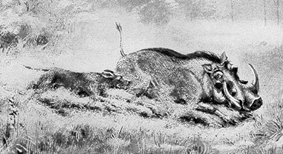HISTORY |
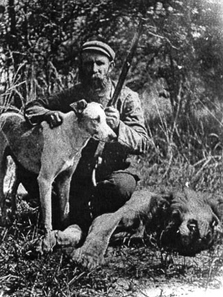
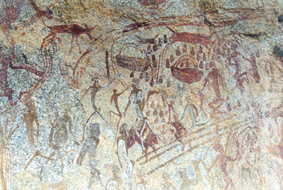
Diana's Vow, a cave near Rusape |
Cornelis van Rooijen and his favourite dog Vlaam ** |
The first pictures of African dogs are to be seen on the cave paintings made by the San (Bushmen) all over Southern Africa. These rock paintings are thousands of years old. On 7th April 1652 the Dutch settled in the Cape under Jan van Riebeeck. By then the Khoikhoi had displaced the San, and they owned ridged hunting dogs who were renowned for their hunting skills. |
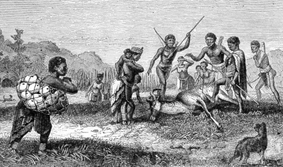
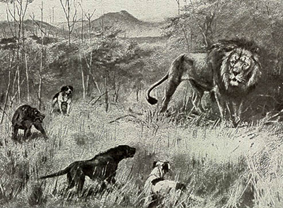
Dr. Livingstone 1875 |
F.C. Selous 1882 |
The early settlers took with them various European hunting dogs, Bloodhound types and Mastiff types for guard purposes. In due time these were interbred with the local ridged dogs. One of the earliest ridged dogs was an engraving in Livingstones book of 1875, "Missionary Travels in South Africa". Another picture of ridged dogs occurs in Frederick Courtenay Selous' book "Travel and Adventure in Africa". This is the hunting pack of Cornelis van Rooijen and in his book gives a vivid account of the hunt. F.C. Selous was the greatest game hunter Africa had. In the 1870's Rev. Charles Helm travelled from Swellendam in the Cape to the Hope Fountain Mission in Matabeleland, Rhodesia. With him he took his 2 ridged dogs: 'Powder' and 'Lorna'. It was at Hope Fountain Mission that Cornelis van Rooijen met these ridged dogs for the first time. |
Van Rooijen farmed at Plumtree, but was better known as a big game hunter, and he kept a big pack of hunting dogs. He admired Helms' ridged dogs for their physique and their guarding character and arrangements were made to breed them with his hunting dogs. The result of the cross was ridged dogs, with red coats and bobbed tails, and they formed the foundation of van Rooijen's pack, which he bred with selectively for the next 35 years to produce a dog with the natural ability to bay lions. In 1897 Francis Barnes co- founded the Salisbury Kennel Club. In 1910 he left Salisbury for Matabeleland and settled on Eskdale Farm at Figtree. In 1915 he purchased his first ridgeback 'Dingo' from Graham Stacey of Inszia, who had obtained his first ridgebacks from Van Rooijen. |
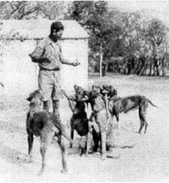
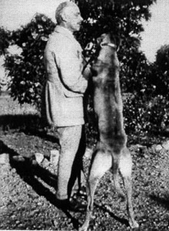
Stacey and pack ** |
Barnes at Eskdale |
Barnes later bought another ridgeback 'Judy', and this was the start of the famous Eskdale Ridgebacks. Barnes became increasingly aware of the need of a Breed Standard, as he was constantly coming across Ridgebacks of a different size, coat and colour. In 1922 a small gathering of seven people met to discuss the problem, and the result was the formation of the Rhodesian Ridgeback Club. |
The first Breed Standard was drawn up later in the same year, and according to Barnes, it owned much to the Breed Standard of the Dalmatian. In fact it has served the breed very well, and has remained virtually unchanged in all the important points, with the exception of eliminating brindle as an acceptable colour and the restriction of white to the feet and the chest. After some time the Rhodesian Ridgeback was officially recognised by the South African kennel Union and the first dogs were registered in September 1924. |
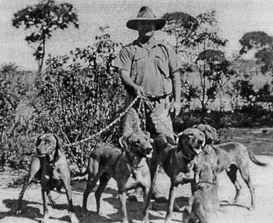
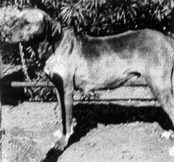
Vernon Brisley and his Viking dogs |
Viking Queen (Jock of Ealing x Viking Lady) 03-02-1929 |
Vernon Brisley farmed from about 1920 at Sandown, beyond Mazoe, towards Centenary. The farm was in the Umvukwes area on the escarpment leading down to the Zambezi Valley. At this time game and predators were moving away, but lions were still being hunted with the dogs being kept on a leash by the dog boys, with up to 4 dogs being handled by one boy. The dogs were kept in runs and exercised. The first dogs probably came from Tractor Smith (Sipolilo). The first Viking registered dog to be found is Viking Lady (bitch) out of Towser and Flossie, born 23-11-1927. Of the Viking dogs, Ella (the niece of Vernon Brisley) remembers Towser, biggish and dark, Queenie and old Ginger. Ginger was bigger and soft natured and was allowed in the home - the other dogs were hunting dogs. The dogs had yellow eyes, and on the hunt the dogs were often clawed - when they died they were full of scars. Queenie was a wonderful hunter who realised she had to get the animal into a shooting position. On the hunt the dogs did not bite the animal at the throat or neck but would nip at the heels. Enough dogs were used to corner the animal and form a ring around it. Horses were not used for hunting as horses were difficult to keep. |
Sources: Rhodesian Ridgeback Pioneers by Linda Costa The Rhodesian Ridgeback Today by Stig Carlson The Complete Rhodesian Ridgeback by Peter Nicholson and Janet Parker Vernon Brisley by Prof. dr. S.V. Potgieter **) reproduced with the kind permission of the author of Rhodesian Ridgeback Pioneers |
